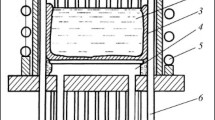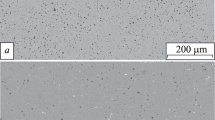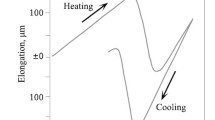Data are provided for preparation of fuzed stabilized zirconium dioxide melted in an ÉDP-600M electric arc furnace. Fuzed lump and granular material is obtained, whose structure is the cubic modification of zirconium dioxide crystals. The possibility is discussed of preparing stabilized zirconium dioxide by electric-arc melting of a zircon charge.
Similar content being viewed by others
Avoid common mistakes on your manuscript.
Zirconium dioxide, having good refractoriness and low thermal conductivity, is classified within a group of promising materials used for enhancement in metallurgy, power generation, chemistry, and glass making. Development and expansion of high technology branches of engineering such as aerospace, electronics, atomic, rocket, etc., are also connected with use of different materials based on zirconium dioxide. Zirconium dioxide, having a crystal lattice monoclinic structure at room temperature, is subject to polymorphic transformation on heating, whose temperature according to data for different researchers may vary [1]. In the range 950 – 1200°C there is transformation of the monoclinic modification (baddeleyite) into tetragonal, stable up to 2200°C, and above 2200°C zirconium dioxide is transformed into a cubic phase. All of the zirconium dioxide crystal forms noted are reversible, and transition from monoclinic phase into tetragonal and conversely is accompanied by a volume change of 3 – 5%.
Volumetric changes of refractory objects, manufactured from zirconium dioxide of monoclinic modification, make it impossible to use them above 1000°C due to cracking. In order to overcome volumetric changes zirconium dioxide is stabilized by converting it into a stable high-temperature cubic modification by introducing oxides structurally similar to it (CaO, MgO, Y2O3, CeO2), forming stable solid solutions. Depending on amount of stabilizer entirely and partly stabilized zirconium dioxide is different. Completely stabilised zirconium dioxide (SZD) is prepared with addition of more 16 mol.% CaO, 16 mol.% MgO, and 8 mol.% Y2O3.
In practice during preparation for ceramic technology highly stable zirconia-containing refractories CaO is used most frequently, and this is confirmed by the large amount of research in the ZrO2–CaO system [1]. Increased strength, good thermal shock resistance, and corrosion resistance has provided extensive use of materials and objects based on SZD in very different branches of engineering. SZD is used most extensively for production of refractories and engineering ceramics [1, 2].
The main SZD producers for CES countries are Ukrainian enterprises: A. A. Berezhnyi OAO UkrNIIO, GP Vol’nogorsk GGMK, and GNPP Tsirkonii. Within Russia in spite of high demand the only enterprise currently producing zirconium dioxide and SZD in an amount of about 6 tons/year, with a requirement for expanding production to 120 tons/year, is OAO Cherepetsk Mechanical Plant [3]. Therefore the most important branches of industry (aviation, space rocket, metallurgy, ceramics, etc.) depend on overseas suppliers, and a severe shortage of SZD is the reason for the limited effective use of it within new industries.
A significant increase in SZD production for industrial purposes (refractories, ceramics, coatings) within Russia is possible with expansion of thermal methods for its preparation. It is assumed that the main methods for SZD preparation using calcium, magnesium, and yttrium oxide additions is electric melting, firing at 1600 – 1900°C, and also heat resistant components from salt solutions. Zirconium compounds are prepared by powder metallurgy methods with a minimum impurity content and SZD prepared in this way is used in medicine for manufacturing special ceramics.
In order to produce refractories for industrial purposes requirements for the impurity content in SZD are somewhat lower, and therefore it is rational to consider electric melting in an arc furnace for its production [4, 5]. Due to a high melting temperature of 2420°C melting zirconium dioxide is a significant difficulty and requires considerable energy expenditure. A second melting difficulty is preparation of a reheated fluid melt with the possibility of maximum pouring from a furnace into a casting mold. Therefore the first series of melts was performed using a binary charge based on zirconium and calcium oxides with addition of up to 6% silica in order to reduce charge refractoriness and improve melt casting properties [6]. These experiments made it possible to determine a rational melting and casting regime for melts containing more than 90% ZrO2 and to work requirements for creating an electric-arc unit with increased energy potential [7].
Systematic studies for preparing fuzed stabilized zirconium dioxide (FSZD) were continued in a modernized EDP-600M unit. The raw material used was baddeleyite powder grade PB-0 (TU 1762-003-00186759–2000) containing, %: ZrO2 ≥ 98.5, SiO2 ≤ 0.4, Fe2O3 ≤ 0.1, TiO2 ≤ 0.13, and chalk (GOST 8253). After melting a charge the melt was held for some time and poured into a graphite mold with preparation after natural firing of a casting weighing 50 kg. A series of melts was also carried out with melt granulation in water. Granulated FSZD is shown in Fig. 1.
According to petrographic analysis data FSZD has an almost polycrystalline structure and consists of zirconium dioxide crystals and a small amount of glass phase, filling spaces between crystals (Fig. 2). A casting structure is a dense mass of quite coarse crystals with sizes of 0.30 – 0.60 mm (see Fig. 2 a ).Within the granulated material structure, which may be considered as uniformly granular, there is a significant amount of individual grains with a size of 0.20 – 0.40 mm (see Fig. 2 b ). The chemical composition of crystals and glass phase of melted material according to x-ray microprobe analysis is provided in Table 1. The crystal phase of a casting is 91.5% ZrO2, 8.5% CaO and for granules it is 91.75% ZrO2, 8.25% CaO, and they are solid solutions in the system ZrO2–CaO [1]. The glass phase of castings and granular material, containing 11.62 – 17.02% ZrO2, 42.95 – 44.79% CaO, 31.82 – 3.02 SiO2, is classified with respect to composition to highly viscous refractory glass.
According to x-ray phase analysis data the sole crystal compound for all of the test melted materials (melt-cast and granular) is zirconium dioxide of cubic modification, which has all the values if interplanar distances of an x-ray diffraction pattern (Fig. 3). It has been shown that with respect to chemical and phase composition, and also structure, there are no fundamental differences for granular materials and castings. However, for castings compared with granules there is a typically coarser zirconium dioxide crystal size.
These studies have demonstrated the practical possibility of preparing FSZD by electric melting of technical raw material (zirconium dioxide or baddeleyite powder) in an arc furnace. It should be noted that zirconium dioxide of metallurgical production and baddeleyite powder are expensive and scarce materials. It may be quite promising to prepare SZD using zircon concentrate as raw material instead of zirconium dioxide. This may be accomplished by electric-arc melting of zircon concentrate with a combination of two processes: desiliciding zircon with carbothermal reduction of silica and stabilization of zirconium dioxide with calcium and yttrium oxides. An important task is determining the maximum amount of residual silica with which total zirconium dioxide stabilization is accomplished.
Preliminary melting of a charge based on ZrO2, SiO2, CaO oxides in an induction furnace showed that the stabilizing effect of calcium oxide within melted materials of the high-zirconia region of the ZrO2–SiO2 – CaO system depends on silica content within the refractory composition [6]. In materials containing 10 – 32% SiO2, calcium oxide is a glass phase component, and has no stabilizing effect for zirconium dioxide. A stabilizing effect is achieved in material with 5% glass phase, within which the main crystal phase is the ZrO2 cubic modification. This material is a product of induction melting FSZD 14 (87.6% ZrO2, 4.5% SiO2, 7.5% CaO). This material, whose structure stabilized zirconium dioxide in the presence of about 5% glass phase, may be a basis both for melted and cast refractories and for refractories prepared by ceramic technology. For melting and casting refractory technology and preparation of crack-free objects presence of structurally stable cubic zirconium dioxide and a small amount of glass phase is important.
A study of desilicided zircon by carbothermal decomposition in an electric-arc furnace has shown that using casting coke as a reducing agent it is possible to prepare melted product containing less than 11% SiO2 [8]. Preparation of FSZD containing less than 5% SiO2 requires marked changes in charge preparation technology and electric-arc melting regime.
The experimental results obtained have made it possible to determine conditions necessary for subsequent industrial test development for preparing FSZD, and also preparation of melted material based on stabilized zirconium dioxide by electric-arc melting of a zircon charge.
References
D. S. Rutman, Yu. S. Toropov, S. Yu. Pliner, et al., High-Temperature Zirconium Dioxide Materials [in Russian], Metallurgiya, Moscow (1985).
A. N. Sokolov, Yu. B. Ashimov, A. V. Bolotov, et al., Melted Refractory Oxides [in Russian], Metallurgiya, Moscow (1988).
V. A. Sokolov, M. D. Gasparyan, and P. P. Mamochkin, “Arc melting plant for synthesizing and producing fusion-cast,” Refract. Indust. Ceram., 50(3), 185 – 188 (2009).
V. A. Sokolov, “Melting zircon in electric-arc furnace — a method for preparing refractory materials and green semifinished products Refract. Indust. Ceram., 55(3), 191 – 193 (2014).
V. A. Sokolov, “Fusion-cast refractories in the high-zirconia region of the ZrO2–SiO2–CaO system,” Refract. Indust. Ceram., 46(3), 197 – 200 (2005).
M. D. Gasparyan and V. A. Sokolov, “Industrial test unit ÉDP-600M for melting refractory oxide materials,” Coll. Sci. Works VI Internat. Sci.-Pract Conf. “Energy saving technology in industry. Furnace Units. Ecology,” ITEP, NITU MISiS, Moscow (2012).
V. A. Sokolov, “Zircon decomposition in an electric-arc furnace,” Tsvetnye Metally, No. 7, 59 – 63 (2006).
The author thanks M. D. Gasparyan, S. V. Makhov, and O. V. Osinin for help in performing this work.
Author information
Authors and Affiliations
Corresponding author
Additional information
Translated from Novye Ogneupory, No. 3, pp. 75 – 78, March 2015.
Rights and permissions
About this article
Cite this article
Sokolov, V.A. Preparation of Fuzed Stabilized Zirconium Dioxide. Refract Ind Ceram 56, 119–121 (2015). https://doi.org/10.1007/s11148-015-9795-3
Received:
Published:
Issue Date:
DOI: https://doi.org/10.1007/s11148-015-9795-3







